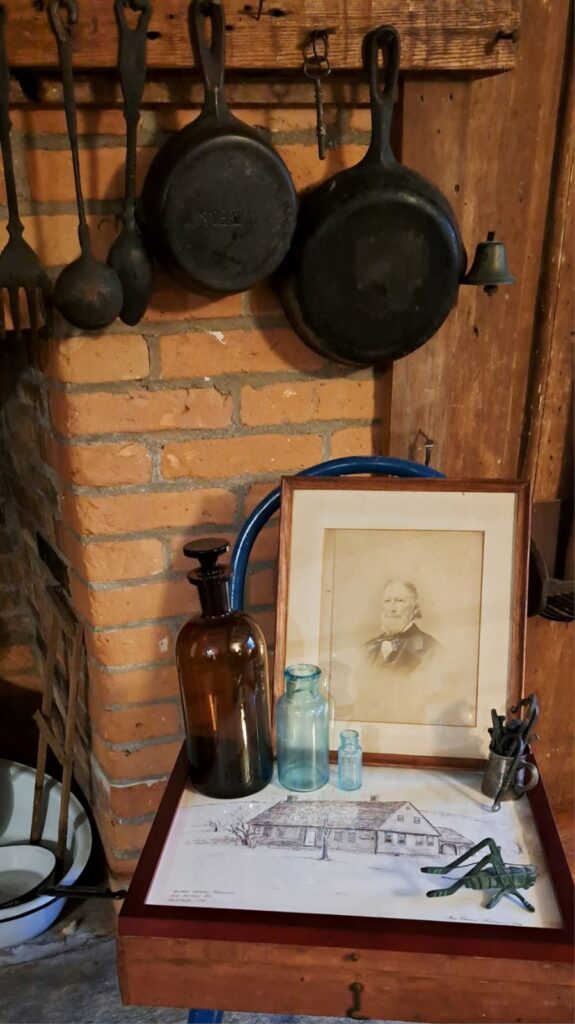This old Norfolk House
Ten Old Colony Road Still Has Many Stories To Tell

Memorabilia from 10 Old Colony Road
By Jane Andrias
Editor’s note: In two past issues, “This Old Norfolk House” has focused on the Stevens House at 10 Old Colony Road. It was occupied by a member of the Stevens family from the late 1800s until well into the 20th century. Jane Andrias, who now owns the house with her husband Rick, reflects on that history.
When my daughter Kate was three years old, her favorite book was The Little House by Virginia Lee Burton. She asked me to read it every night at bedtime. The book is about a little house in the country that shelters the family who built it. Over time the house is abandoned and falls into disrepair. The great, great granddaughter of the man who built it discovers it. Nostalgic for her happy childhood days, she buys the house, has it transported to the country, repairs it and moves in. Burton’s story reassures us that a vulnerable structure can be brought back to life
I was touched by the Stevens’ house the moment I saw it. The house’s understated but confident presence, subtly demanding respect, made me wonder about who came before and how each family made it a home with its own stories, secrets, and truths. When would I know that this was mine, and would become an expression of myself?
During the process of purchasing the house, we visited Daniel and Dianne Romano, the owners whose three children grew up in the house. Ten Old Colony was their primary residence. It was where they shaped their lives and lived their love and challenges. I had just read a piece about the value of nostalgia and during our visit, I noticed that Daniel, a psychiatrist, was quiet and distant. I asked him how he held the idea of nostalgia. He gazed into the distance and said softly, “It is helpful.” His wistful response has stayed with me.
When we finally took residence, the only real change we made at first was converting a very large, room size closet into a playroom for our grandchildren. We also added a studio above the garage for my books and do my art and be all by myself.
At what point did we really move ourselves into the house and begin to make it our own? It was the curiosity and authority of our then two-year old granddaughter that drew us out of our awe and inactivity. She took us on a tour beginning with the room she named “the Liberry” because it has shelves for books. She proceeded to designate each space for the use they did become, as eager to make it her “little house” as she was to imagine what the rooms were called by the last family. Our other two grandchildren reveled in locating the many exits and entries to the house, which gave them more access to the outside world than they had ever experienced.
The children brought the house, the barn and the land to life. They presented it to us through their eyes along with their enthusiasm and imagination, opening possibilities to us. The house began to be ours. During Covid, I created a puzzle of the house’s interior which is assembled by solving the clues corresponding to each room and sent it off to my grandchildren who were missing the house.
The house can seem set in its ways. Yet, the utilitarian and elegant interior design has allowed for our choices and tastes. We noticed objects, pieces of furniture, artifacts left behind by prior owners and found ourselves guarding them: wrought iron hooks fastened to the kitchen wall; fireplace implements propped up against its bricks; old glass bottles; photos that document the house.
For me, the 300-year-old barn, once the site of the Stevens’ Haberdashery, has become my most special location. Every year, when spring returns, I rake the underneath floor and the stalls as though I am preparing the space for the goats and horses which once resided there. Upstairs, I open all the doors to discover the remnants of the winter inhabitants. As I sweep it clean and rearrange what has been dislodged, I remind the creatures that are still lurking that I know they were here before I was and that I am just a seasonal occupant. I wipe the tools left from the farming days, holding them to feel the hands before me. I arrange them to be in the company of my collection of bones and tools to be seen but out of the way of the children’s games.
Ten Old Colony still stands firmly in its original surround. It has shown versatility. It has roots and history that anchor and connect us what came before. It is a site of memory, a space of time compressed. Our hands move along the same banister, release the same door latches, sweep the same fireplaces as the Stevenses and the Romanos. I wonder how long this will be ours before it moves into the lives of others.
Ten Old Colony stands between Haystack Mountain Road, lively with curious hikers, and the Center Cemetery where history lays deep. It is almost just a moment between life and death. Maybe that is the house’s greatest gift. It is a reminder of time past, time moving and the stillness of time.
